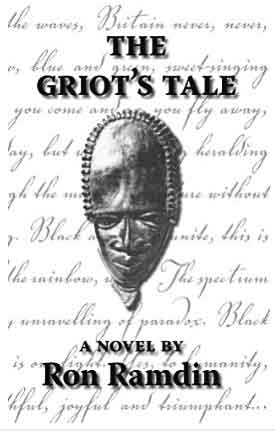Book Review
Ramdin's 'Griot's Tale'
Trafford Publishing, 2009, pp.480. ISBN 978-1-4251-8406-3.

A review by Frank Birbalsingh
Born in Trinidad, Ron Ramdin is a biographer, editor, historian and novelist who now lives in the United Kingdom. The Griot's Tale is his second novel, after Rama's Voyage (2004). In Rama's Voyage, Ramdin dramatises the experience of Indians who went to the Caribbean as indentured workers mainly in the second half of the nineteenth century, while in The Griot's Tale he explores African slavery chiefly in the late eighteenth and early nineteenth century Caribbean. This second novel also examines living conditions of freed Africans in England about the same time, and efforts to abolish the slave trade.
In The Griot's Tale the narrator Adamah is a freed African who lives in a poor district of London where he acquires notoriety as: "rabble-rouser, radical, passion-charged moralist, persuasive speaker and preacher" among fellow "Black-birds" as people of colour were known, around 1807, when the African slave trade was abolished in England. Full abolition of slavery itself would not come until 1834. Adamah composes his narrative while he awaits the verdict during his trial for murder. According to him, his narrative should be seen as: "a faithful record of the truth of my life and times, a story that I'd like to be passed on not only among those who live now but also to those yet unborn."
By his account, Adamah's mother Mina was only sixteen when she was kidnapped in her West African homeland and taken as a slave to a Caribbean island that is never named. After being raped by her English owner, Mina gives birth to Adamah aboard ship, and is then beaten for having a child when they land. Yet Adamah has nothing but praise for his mother who has a lasting influence on him through her teaching about the African oral tradition as a repository of learning and wisdom. It is out of respect for this tradition that she names him Adamah "the Griot" or story teller.
At the age of eleven, however, after he has learnt to speak English and become a Christian, Adamah is taken to England by his master and given his freedom. His adventures that then follow, mainly in London, remind us of eighteenth century paintings of English society ladies who retain black boys as trophies. When he joins the household of Lady Candida, for instance, Adamah writes: "I'd graduated from being a plantation slave and servant in the island 'Big House' to a human pet." He eventually settles in a poor, multicultural community around Sugar Loaf Lane, populated mainly by: "mendicants, missionaries, beggars, boxers, writers and preachers of all kinds from different lands." This is where most of the action of the novel is enacted as he becomes Minister of Flagstaff Square Church, and conducts a vigorous programme of speaking, writing and agitation against slavery and the slave trade. He also marries an English woman Rachele and shares in her grief when she loses their first child.
In one instance, during his often strident agitation against racism when he himself produces essays such as "Our common Rights" and "Religion, Hypocrisy and Slavery" with criticism of white Abolitionists who parade insincere humanitarian motives, Adamah agrees, along with "'brothers' and fellow-pleaders of our 'Cause,'" to visit the home of Sir Henry Meadows, a Government Minister, and discuss local issues of unemployment and poverty. After they enter Sir Henry's house, however, Adamah and his three "friends" are confronted by Sir Henry's butler, and Adamah sees one "friend" stab the butler with a pike which he then gives to Adamah before he and his mates escape, leaving Adamah with the murder weapon that leads to his arrest, and eventual hanging. Only afterwards does it dawn on Adamah that one of his so called friends was a police informer.
In a lengthy narrative crowded with dozens of characters, copious descriptions of people, places and issues, including names of streets, buildings, and titles of books, pamphlets and newspapers, Ramdin deserves credit for his formidable research and scholarship in dramatising actual events and re-creating historical personalities like Mr. Malleson, a Member of Parliament probably based on William Wilberforce, the British MP who helped passage of the Abolition bill through the British House of Commons in 1834. Also, Ramdin's character Mr. Bizbee indefatigably collects evidence of the manifold injustices of slavery like the historical Thomas Clarkson who wrote a major anti-slavery text. Fictional names also appear in The Griot's Tale for African authors who expose abuses of slavery.
Authors of historical fiction generally steer between two literary genres trying not to slip completely either into history or fiction. But while Ramdin's richly textured details and gracefully fluent writing emphasise the solid historical value of his portrait of eighteenth and early nineteenth century London, and the day to day activities of Abolitionists, they also tend to give The Griot's Tale an impression of being a largely journalistic or historical guide to the Abolition saga within an Hogarthian context of gin drinking, boxing, Blacks and other jobless or starving people in London. This impression is also somewhat reinforced by the final one third of the novel which is devoted entirely to an interrogation of the narrator by the Reverend William Bragg, and a protracted discussion of moral and philosophical issues arising out of African slavery.
Yet it is strange how revelations both about Reverend Bragg and the narrator, at the end of their frankly polemical discussion, induce deep and dramatic feelings of surprise, suspense, and even shock that help to redeem the fictional balance of the novel. Thus, despite the multiplicity of its minor characters and the superabundant polemical energy of its multifarious discussions, the narrator's unjust hanging for a murder he did not commit, and his family relationships, firstly with Rachele, then with their daughter Elizabeth who writes a moving Epilogue about her subsequent connection with Reverend Bragg, contribute immensely to the human interest that sustains the fictional integrity of The Griot's Tale.